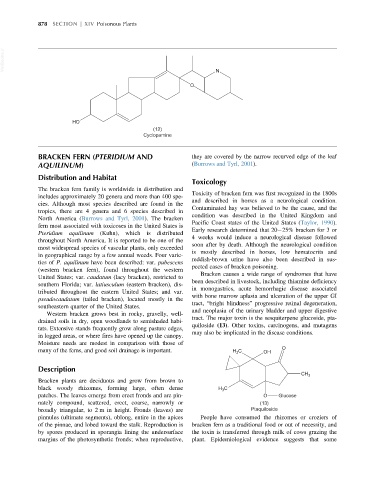Page 924 - Veterinary Toxicology, Basic and Clinical Principles, 3rd Edition
P. 924
878 SECTION | XIV Poisonous Plants
VetBooks.ir N
O
HO
(12)
Cyclopamine
BRACKEN FERN (PTERIDIUM AND they are covered by the narrow recurved edge of the leaf
AQUILINUM) (Burrows and Tyrl, 2001).
Distribution and Habitat
Toxicology
The bracken fern family is worldwide in distribution and
Toxicity of bracken fern was first recognized in the 1800s
includes approximately 20 genera and more than 400 spe-
and described in horses as a neurological condition.
cies. Although most species described are found in the
Contaminated hay was believed to be the cause, and the
tropics, there are 4 genera and 6 species described in
condition was described in the United Kingdom and
North America (Burrows and Tyrl, 2001). The bracken
Pacific Coast states of the United States (Taylor, 1990).
fern most associated with toxicoses in the United States is
Early research determined that 20 25% bracken for 3 or
Pteridium aquilinum (Kuhn), which is distributed
4 weeks would induce a neurological disease followed
throughout North America. It is reported to be one of the
soon after by death. Although the neurological condition
most widespread species of vascular plants, only exceeded
is mostly described in horses, low hematocrits and
in geographical range by a few annual weeds. Four varie-
reddish-brown urine have also been described in sus-
ties of P. aquilinum have been described: var. pubescens
pected cases of bracken poisoning.
(western bracken fern), found throughout the western
Bracken causes a wide range of syndromes that have
United States; var. caudatum (lacy bracken), restricted to
been described in livestock, including thiamine deficiency
southern Florida; var. latiusculum (eastern bracken), dis-
in monogastrics, acute hemorrhagic disease associated
tributed throughout the eastern United States; and var.
with bone marrow aplasia and ulceration of the upper GI
pseudocaudatum (tailed bracken), located mostly in the
tract, “bright blindness” progressive retinal degeneration,
southeastern quarter of the United States.
and neoplasia of the urinary bladder and upper digestive
Western bracken grows best in rocky, gravelly, well-
tract. The major toxin is the sesquiterpene glucoside, pta-
drained soils in dry, open woodlands to semishaded habi-
quiloside (13). Other toxins, carcinogens, and mutagens
tats. Extensive stands frequently grow along pasture edges,
may also be implicated in the disease conditions.
in logged areas, or where fires have opened up the canopy.
Moisture needs are modest in comparison with those of
O
many of the ferns, and good soil drainage is important. H 3 C OH
Description
CH 3
Bracken plants are deciduous and grow from brown to
black woody rhizomes, forming large, often dense H 3 C
patches. The leaves emerge from erect fronds and are pin- O Glucose
nately compound, scattered, erect, coarse, narrowly or (13)
broadly triangular, to 2 m in height. Fronds (leaves) are Ptaquiloside
pinnules (ultimate segments), oblong, entire in the apices People have consumed the rhizomes or croziers of
of the pinnae, and lobed toward the stalk. Reproduction is bracken fern as a traditional food or out of necessity, and
by spores produced in sporangia lining the undersurface the toxin is transferred through milk of cows grazing the
margins of the photosynthetic fronds; when reproductive, plant. Epidemiological evidence suggests that some

